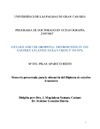Please use this identifier to cite or link to this item:
https://accedacris.ulpgc.es/jspui/handle/10553/2947
| DC Field | Value | Language |
|---|---|---|
| dc.contributor.advisor | Santana-Casiano, J. Magdalena | - |
| dc.contributor.advisor | González Dávila, Melchor | - |
| dc.contributor.author | Aparicio-Rizzo, Pilar | - |
| dc.date.accessioned | 2010-02-04T02:31:00Z | |
| dc.date.accessioned | 2018-05-15T10:55:14Z | - |
| dc.date.available | 2018-05-15T10:55:14Z | - |
| dc.date.issued | 2010 | en_US |
| dc.identifier.uri | https://accedacris.ulpgc.es/handle/10553/2947 | |
| dc.description | Programa de Doctorado en Oceanografía | en_US |
| dc.description.abstract | In the frame of CARBOOCEAN project the QUIMA-VOS line is monthly monitoring the eastern South Atlantic Ocean, measuring surface temperature, salinity, oxygen and chlorophyll a. In this work the annual pattern of oxygen, chlorophyll a, temperature and salinity are presented for seven different regions which from Equator to south: Equatorial Divergence Zone (0º-5ºS), Congo-Angola region (5º-10ºS), Angola Gyre region (10º-14ºS) and Northern Namibian region (14º-20ºS) all of them inside the Eastern Tropical Atlantic Province (ETRA). Central Namibian region between 20º-24ºS inside South Atlantic Gyral Province (SALT), Lüderitz region (24º-28ºS) and Southern Benguela region at 28º-33ºS inside the Benguela Current Coastal Province (BENG). An inverse correlation between the temperature and the oxygen is observed related to its effect on the solubility of the gas. The role and influences of the different oceanographic structures on the oxygen and chlorophyll a measurements is described considering the Angola Gyre, the Angola-Benguela Front, the Benguela Current system (oceanic and coastal) and the Benguela Upwelling system. The relationship between the parameters and the oceanographic structures divides the Southeast Atlantic in two big areas separated by the Angola Benguela Frontal Zone. | en_US |
| dc.language | eng | en_US |
| dc.subject | 2391 Química ambiental | en_US |
| dc.subject | 2307 Química física | en_US |
| dc.subject.other | Oxygen | en_US |
| dc.subject.other | South Atlantic | en_US |
| dc.subject.other | Chlorophyll | en_US |
| dc.title | Oxygen and Chlorophyll Distribution in the Eastern Atlantic Ocean from 0º to 35ºS. | en_US |
| dc.type | info:eu-repo/semantics/masterThesis | en_US |
| dc.type | MasterThesis | en_US |
| dc.compliance.driver | 1 | es |
| dc.contributor.facultad | Facultad de Ciencias del Mar | en_US |
| dc.identifier.absysnet | 585406 | |
| dc.identifier.crisid | -;1562;2199 | |
| dc.investigacion | Ciencias | en_US |
| dc.type2 | Trabajo final de máster | en_US |
| dc.description.notas | Programa de doctorado en Oceanografía. Trabajo presentado para la obtención del Diploma de Estudios Avanzados. | en_US |
| dc.utils.revision | Sí | en_US |
| dc.identifier.ulpgc | Sí | en_US |
| dc.contributor.buulpgc | BU-BAS | en_US |
| item.grantfulltext | open | - |
| item.fulltext | Con texto completo | - |
| crisitem.advisor.dept | GIR IOCAG: Química Marina | - |
| crisitem.advisor.dept | IU de Oceanografía y Cambio Global | - |
| crisitem.advisor.dept | Departamento de Química | - |
| crisitem.advisor.dept | GIR IOCAG: Química Marina | - |
| crisitem.advisor.dept | IU de Oceanografía y Cambio Global | - |
| crisitem.advisor.dept | Departamento de Química | - |
| Appears in Collections: | Trabajo final de máster | |
Page view(s)
78
checked on Jul 27, 2024
Download(s)
63
checked on Jul 27, 2024
Google ScholarTM
Check
Share
Export metadata
This item is licensed under a Creative Commons License

